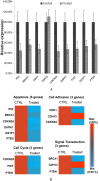Basic studies on epigenetic carcinogenesis of low-dose exposure to 1-trichloromethyl-1,2,3,4-tetrahydro-β-carboline (TaClo) in vitro
- PMID: 28199384
- PMCID: PMC5310788
- DOI: 10.1371/journal.pone.0172243
Basic studies on epigenetic carcinogenesis of low-dose exposure to 1-trichloromethyl-1,2,3,4-tetrahydro-β-carboline (TaClo) in vitro
Abstract
1-Trichloromethyl-1,2,3,4-tetrahydro-β-carboline (TaClo) has been widely studied as a neurotoxic substance, however, only few reports have explored its effect on carcinogenicity. Since the aberrant modification of DNA methylation occurs very early in almost all human cancers, the focus of this study is to assess the carcinogenicity of TaClo by characterizing alterations of the epigenetic state, specifically, DNA methylation, upon exposure to TaClo in a HEK 293 model cell line. Our results suggest that TaClo could induce global DNA hypomethylation and transcriptional repression of critical tumor suppressor genes by increasing their promoter methylation. Enhanced cell proliferation, migration and anchorage independent growth were observed in cells exposed to TaClo. Our study highlights the epigenetic toxicity of TaClo, which contributes to its carcinogenicity by altering the DNA methylation status.
Conflict of interest statement
Figures








Similar articles
-
Effect of 1-trichloromethyl-1,2,3,4-tetrahydro-beta-carboline (TaClo) on human serotonergic cells.Neurochem Res. 2000 Jun;25(6):837-43. doi: 10.1023/a:1007521625088. Neurochem Res. 2000. PMID: 10944002
-
Biochemical lesions of the nigrostriatal system by TaClo (1-trichloromethyl-1,2,3,4-tetrahydro-beta-carboline) and derivatives.J Neural Transm Suppl. 1995;46:275-81. J Neural Transm Suppl. 1995. PMID: 8821064
-
The TaClo concept: 1-trichloromethyl-1,2,3,4-tetrahydro-beta-carboline (TaClo), a new toxin for dopaminergic neurons.J Neural Transm Suppl. 1995;46:235-44. J Neural Transm Suppl. 1995. PMID: 8821060 Review.
-
Modification of tyrosine hydroxylase activity by chloral derived beta-carbolines in vitro.J Neurochem. 2002 May;81(4):814-9. doi: 10.1046/j.1471-4159.2002.00875.x. J Neurochem. 2002. PMID: 12065640
-
TaClo as a neurotoxic lead: improved synthesis, stereochemical analysis, and inhibition of the mitochondrial respiratory chain.J Neural Transm Suppl. 1995;46:245-54. J Neural Transm Suppl. 1995. PMID: 8821061 Review.
Cited by
-
1-Trichloromethyl-1,2,3,4-tetrahydro-beta-carboline (TaClo) Alters Cell Cycle Progression in Human Neuroblastoma Cell Lines.Neurotox Res. 2017 Nov;32(4):649-660. doi: 10.1007/s12640-017-9782-1. Epub 2017 Jul 18. Neurotox Res. 2017. PMID: 28721631
References
-
- Bringmann G, Feineis D, God R, Maksimenka K, Mühlbacher J, Messer K, et al. Resolution and chiroptical properties of the neurotoxin 1-trichloromethyl-1,2,3,4-tetrahydro-β-carboline (TaClo) and related compounds: quantum chemical CD calculations and X-ray diffraction analysis. Tetrahedron. 2004;60(37):8143–8151.
-
- Bringmann G, Feineis D, BruÈckner R, Blank M, Peters K, Peters ME, et al. Bromal-derived tetrahydro—carbolines as neurotoxic agents: Chemistry, impairment of the dopamine metabolism, and inhibitory effects on mitochondrial respiration. Bioorganic & Medicinal Chemistry. 2000;8(6):1467–1478. - PubMed
-
- Statement S. "Summary statement—12.20 Chloral hydrate (trichloroacetaldehyde)". World Health Organization. Summary statement 2013;14:1–2.
MeSH terms
Substances
LinkOut - more resources
Full Text Sources
Other Literature Sources
Miscellaneous

